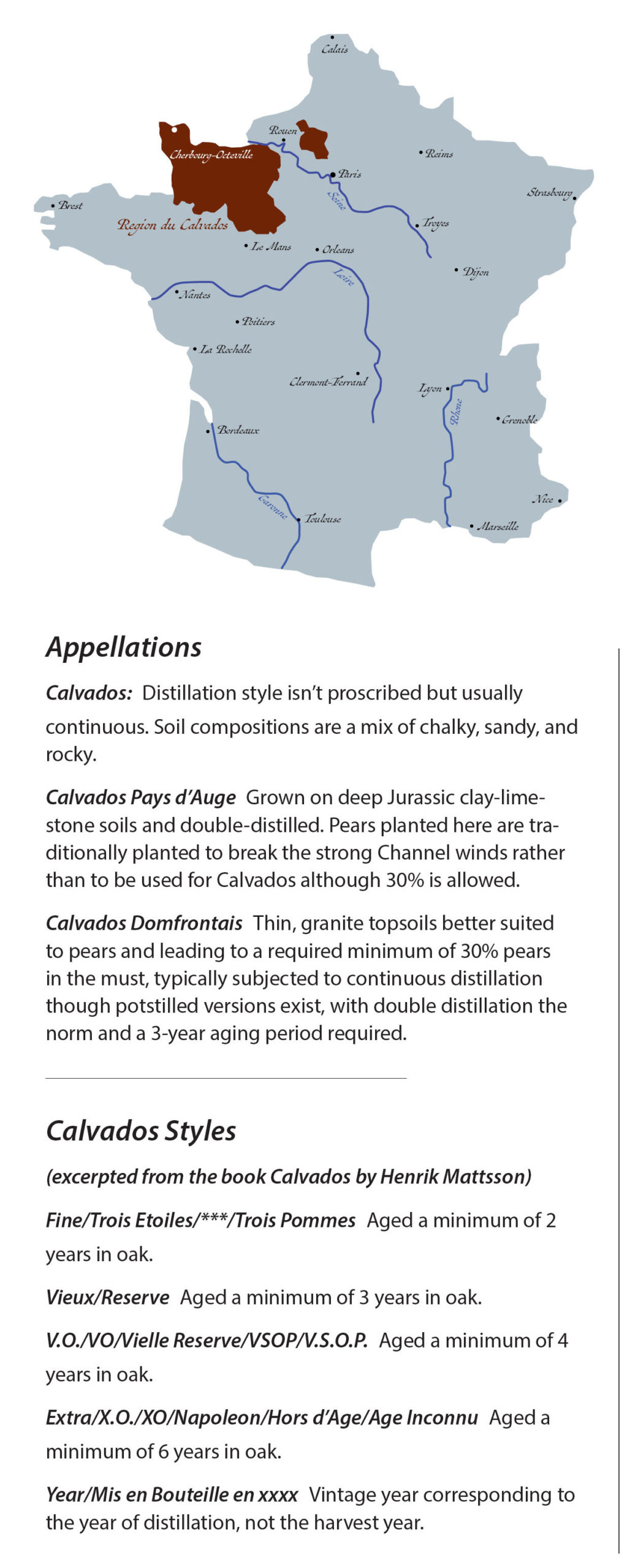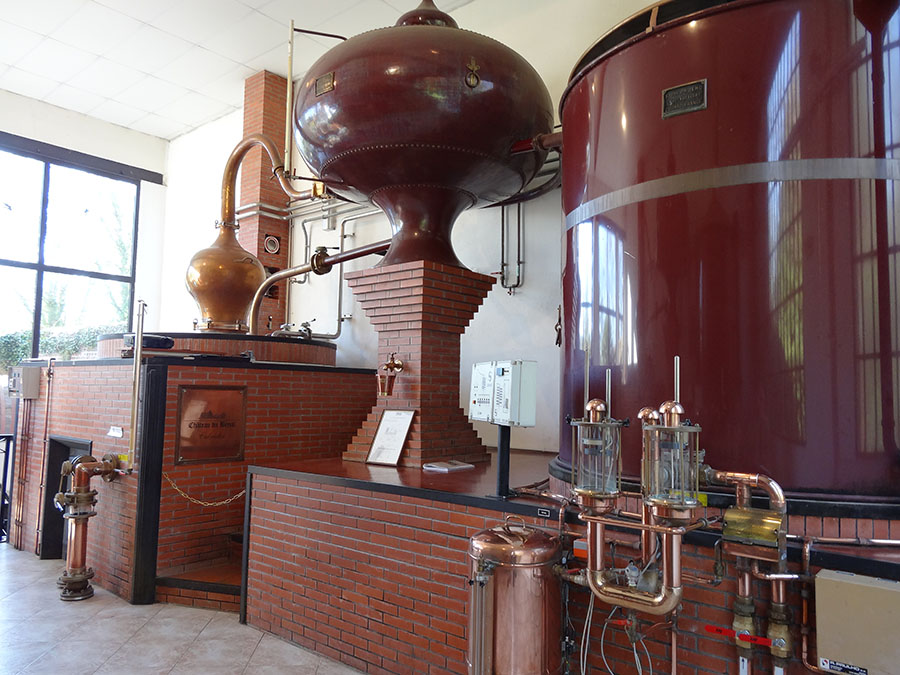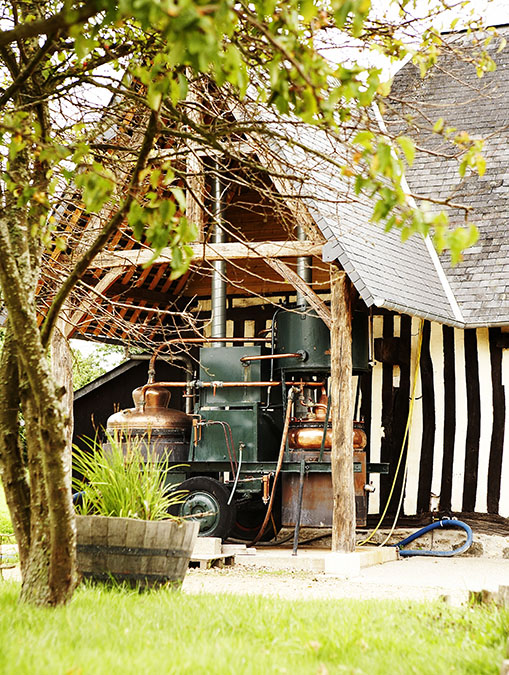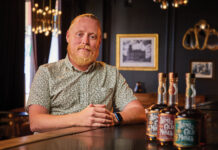When Romans arrived in northern France two millennia ago they found the locals drinking not water but a rough cider from wild apples. According to records from that time it tasted awful but was preferable to falling ill from water supplies tainted by a range of animal excrement. Distillation here likely dates to monks’ usage of it for medicinal preparations as far back as the 7th century but it wasn’t until the 16th century when the Normans brought varieties from Asturias, grafting them upon the local rootstocks, that cider became a product to be savored and then distilled into its essence.
Today there are no fewer than 250 apple varieties within the Pays d’Auge heartland of Calvados in France’s Normandy region. Its orchards are planted to both traditional high-stem and modern low-stem grafting for the region’s 10,000 licensed producers. The average lifespan of a productive apple tree is 30 years, although some live far longer with pear trees, which have a minority though relevant presence here, living as long as 300 years with the presence of pear helping to lower the ambient humidity of the air for the nearby apple trees. In former times there was approximately 10% of pear used in the production of cider, pommeau (a blend of fresh cider and distilled spirit) and Calvados. Apples are classified as bitter, bittersweet, sweet and acidic with a varying mix of these widely viewed as desirable so as to obtain each producer’s preferred balance between tannin, sugar, and acid for their Calvados.
AOC status was granted Calvados in 1942 to protect the region from war requisitions with its western Domfrontais district given separate AC status in 1997. The first distillation of cider yields an intermediate product with a strength of approximately 30% from which the heads and tails are eliminated. These ‘petites eaux’ are then distilled a second time. As it emerges from the still Calvados is colorless, produces a burning sensation on the palate, and gives off aromas of fruit and alcohol. Whether continuous- or double-distilled all raw spirit here must be 69-72% abv before being placed in wood for aging where caramel and sugar are allowed (though eschewed by the better distillers) and the ‘angel’s share’ varies between .08-4% annually.

The CalvaClub Idea Added Mixologists to the Mix
A veteran press officer of France24, the Interprofession des Appellations Cidricoles’ (IDAC) Communications Director Damien Amadou came aboard in 2019 to better delineate Calvados with the other orchard fruit products associated with it, and “to develop a Calvados ‘eco-system’ of messaging founded with DrinkCalvados.com for which we’ve many initiatives and campaigns to promote it.” US marketing plans are under consideration possibly to emulate the spring 2021 CalvaClub concept it created in Deauville France in which it selected 12 cocktail video presentations made by mixologists who recreated them. “Calvados’ existence depends upon its 3m trees, so environmental concerns, our decarbonized economy, are always top of mind.” 4.2m bottles of Calvados were sold in 2020 with the US and Canada accounting for 4% of that.
Stately 16th century Chateau du Breuil rests behind its 18th century distillery building which has housed textile, cheese, and chocolate production until finally being converted into Calvados production in 1954. Its two computer-controlled double stills source cooling water from the River Touques running below the distillery. Formerly owned by external interests, today it’s overseen by Frédéric Dussart with his son, François, its Chief Marketing Officer. Its 10 minority shareholders are comprised of friends, family, two US venture capitalists from the IT business (the elder Dussart until 2016 was Dell Computer’s Senior VP for EMEA and ASIA -PAC), two executives from Lanson Champagne group with the last his main supplier of casks. A related ‘side hustle’ of Dussart’s is the winery Domaine des Chauchoux in Burgundy’s Côte Chalonnaise. So why the move from tech to drinks? “I love wines and spirits, so creating and developing a portfolio of Calvados with a strong spiritourism aspect is pretty unique in France. Doing that as a family business with trusted friends is a dream come true for an entrepreneur.” Chateau du Breuil’s Calvados ranging from its basic Fine to its 20yrs. old are imported by Pacific Edge whose VP Scott Tallon said that he’s, “seen a nice uptick in sakes 2021 vs. 2020 with 2021 exceeding pre-Covid numbers with the introduction of the unique 8yrs. matured in Sauternes and Port Casks helped bring attention to the Calvados category by peaking curiosity with these innovations in the aging a classic spirit.” Tallon added that its 12yrs. bottling is being carried nationwide by Total Wine and More as an exclusive offering.

© David Morganti
Domaine Dupont’s Marie Marois shared with me “in 2014-2015 we invested in a second 12.5 HL repasse still to double our distillation capacity, planted 10 hectares of trees bringing our total orchard surface to 66 acres.” She confirmed what I already knew that it never adds sugar or caramel but surprised me with the news that its first organic Calvados is in preparation for release no sooner than 2024. Jonathan Nahrgang, President of Montaigne Imports, sells Dupont’s Calvados into 16 states including such rarities as vintages 1980 and 1988, unreduced 30 and 45 year old versions, and an Islay Cask finish bottling. “Our sales were up 25% in 2021, but this is still lacking any real progress in the on-premise since we battle with distributors very hesitant to bring on new products or brands during the pandemic,” though Nahrgang remains bullish on the potential of Calvados with mixologists. “We think the flavor profiles of younger Calvados along with the innovations of Dupont’s Cream Liqueur and Islay Whiskey Cask finish offer on-premise cocktail programs interesting alternatives.”

France’s Calvados Market is Deep
Pierre Martin Neuhaus oversees his family owned and operated Coquerel distillery, Calvados’ third largest and the largest independent one producing 625,000 700ml bottles annually. “We control the production process from blossom to bottle with our own orchards also buying apples and pears from farmers within 30km of the distillery. We naturally ferment our ciders for a minimum of 28 days and then distill them in 3 traditional calvados copper stills with all spirits then aged in French oak barrels, a mix of new sourced from Bordeaux and Cognac, ex-rum and ex-Cognac casks, and some former fortified wine barrels before blending and bottling.” Neuhaus’ house recipe is based upon no fewer than 40 varieties of apples and pears from including “20% sharp ones to bring equilibrium and harmony,50% bittersweet to bring tannins, 20-25% sweet for sweetness, and 5-10% bitter sharp for freshness.” Imported into the US by Jean-François Bonnete of his eponymous company, Coquerel is now distributed in 25 states with plans in place to expand to 35 states in 2022. “Coquerel finished 2021 with a growth of 39%, tripling in volume since 2019, and we expect to grow the brand by more than 50% in 2022,” he stated confidently. “Many American consumers are familiar with apple brandy but not necessarily with Calvados. When running Maison Ferrand for the United States 24 years ago, it was mainly top chefs and a few sommeliers interested in Calvados, and rare were the consumers who knew about Calvados.” He continued that, “thanks to the growing interest in cocktails and demand for authentic, terroir-driven spirits, Calvados has begun to benefit in a manner not unlike what Mezcal began with over 20 years ago.” Bonnete listed amongst his sales successes Spec’s in Texas, BevMo in California, and Binny’s in Chicago while “we see more and more bartenders featuring cocktails with Calvados.”
Montpellier-trained winemaker Guillaume Drouin has admirably stepped into his father Christian’s formidable shoes, maintaining the traditional 1940s mobile still which they use for their distilling needs. Drouin uses a traditional square hydraulic press for the pressing of the thirty varieties of apples of a selection typical of the Pays d’Auge–60% are selected for sweet or bittersweetness, 10% for tartness, and 40% for tannin structure and aromatics. Two year old oak barrels formerly containing wine are first filled with cider to help remove any remaining wine character, then removed for distillation, then to be filled with the finished distillate. As with other quality-minded producers Drouin adds neither caramel nor sugar.

The Exporter View
Serge Dersahaguian is the CEO of Spirit France, the largest exporter by volume and value of Calvados to the US with its three brands of Père Magloire and Boulard, and Lecompte which amongst them account for half the appellation’s exported volume (excluding bulk). Boulard is recognized as more premium due to historical factors and the fact that Père Magloire Fin VS column-distilled has focused on the off-premise whereas Boulard is pot-stilled and focused upon the on-premise. “While Calvados doesn’t have in the US the prestige nor sales of Cognac, bourbon, and single malt whisky, Boulard Pays d’Auge has for 25 years been to the US the most visible brand for quality Calvados. With the rise of craft spirits we see a chance to grow, especially in the bigger markets with on-trade being the key to success.” When prompted to wonder why it is that Calvados hasn’t enjoyed the level of interest other historic spirits with a story to sell have, Dersahaguian mused that “it’s been a secret for the Parisiens who like to keep to themselves the 2hrs. drive from their home that is the pastoral, gastronomic destination of Calvados.” David Singh of Palm Bay manages Chateau Boulard for its US importer of Palm Bay. “One of the biggest challenges of selling Calvados is trade buyer’s and therefore consumers’ awareness since the category is a little quiet, with consumers usually introduced to it by a well-informed mixologist or somm.” Currently available in 42 markets Singh has seen a significant growth of Boulard’s US sales from 3,000 cases in 2018 to 5,000 in 2021.”
Purchased by the La Martiniquaise group in 2003, Karine Vigneron of Busnel distillery has seen sales increase with its long-time US importer of Evaton in 2021 in the 27 states it sells into led by Illinois, New York, Maryland, Georgia, Tennessee, California, Colorado, Arizona and Washington. Brand Manager April Gordon said that “the pandemic hit us hard but previous to that it was very successful in the on-trade,” and saw surges without knowing why until discovering its association as a comfort drink with French expats. “NYC mixologists love the value it adds to cocktails” with national on-premise independent sales climbing 95% in 2021 and chains like Disney climbing 87%. “It takes a lot of basic education in tastings for bar staff. Our VSOP stock ran out quickly, and the brand sales increased slightly during the pandemic.” Busnel both buys its apples from long term contract growers along with maintaining its own orchards located close to its Honfleur base of operations. “We are committed to reducing our environmental impact, recycling 100% of our apple waste after harvesting, and this year we’ll install chickadee nesting boxes in our orchards to limit the use of insecticides.” Busnel produces a range of organic Calvados, strengthening its commitment to sustainability.
In addition to these Calvados distilleries du Manoir de Montreuil, du Tertre, Eric Bordlet, Morin, and Roger Groult are also imported into the US with a newly created brand, Avallen, founded upon its sustainability credentials set to complete its US entry by the end of 2022 with Zev Rovine Selections.








